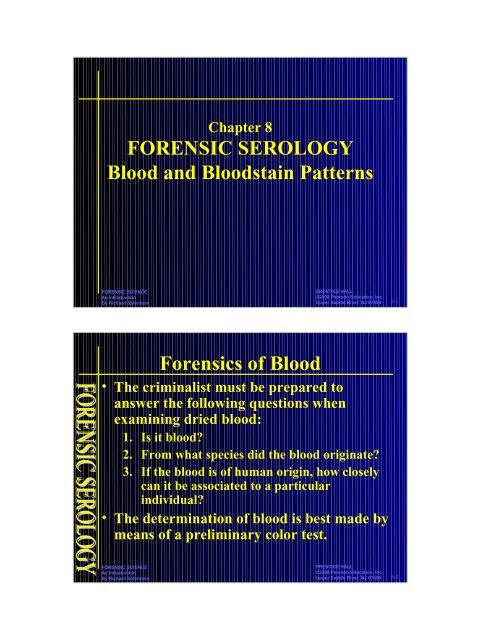Bloodstain Patterns - Mr. Catt's Class
Bloodstain Patterns - Mr. Catt's Class
Bloodstain Patterns - Mr. Catt's Class
Create successful ePaper yourself
Turn your PDF publications into a flip-book with our unique Google optimized e-Paper software.
Chapter 8<br />
FORENSIC SEROLOGY<br />
Blood and <strong>Bloodstain</strong> <strong>Patterns</strong><br />
FORENSIC SCIENCE<br />
An Introduction<br />
By Richard Saferstein<br />
PRENTICE HALL<br />
©2008 Pearson Education, Inc.<br />
Upper Saddle River, NJ 07458<br />
Forensics of Blood<br />
• The criminalist must be prepared to<br />
answer the following questions when<br />
examining dried blood:<br />
1. Is it blood?<br />
2. From what species did the blood originate?<br />
3. If the blood is of human origin, how closely<br />
can it be associated to a particular<br />
individual?<br />
• The determination of blood is best made by<br />
means of a preliminary color test.<br />
FORENSIC SCIENCE<br />
An Introduction<br />
By Richard Saferstein<br />
PRENTICE HALL<br />
©2008 Pearson Education, Inc.<br />
Upper Saddle River, NJ 07458<br />
8-1<br />
8-2
The Tests<br />
• A positive result from the Kastle-Meyer color<br />
test is highly indicative of blood.<br />
– Hemoglobin causes a deep pink color.<br />
• Alternatively, the luminol test is used to search<br />
out trace amounts of blood located at crime<br />
scenes.<br />
– Produces light (luminescence) in a darkened area.<br />
• Microcrystalline tests, such as the Takayama<br />
and Teichmann tests, depend on the addition<br />
of specific chemicals to the blood so that<br />
characteristic crystals will be formed.<br />
FORENSIC SCIENCE<br />
An Introduction<br />
By Richard Saferstein<br />
FORENSIC SCIENCE<br />
An Introduction<br />
By Richard Saferstein<br />
PRENTICE HALL<br />
©2008 Pearson Education, Inc.<br />
Upper Saddle River, NJ 07458<br />
PRENTICE HALL<br />
©2008 Pearson Education, Inc.<br />
Upper Saddle River, NJ 07458<br />
8-3<br />
8-4
FORENSIC SCIENCE<br />
An Introduction<br />
By Richard Saferstein<br />
PRENTICE HALL<br />
©2008 Pearson Education, Inc.<br />
Upper Saddle River, NJ 07458<br />
The Tests<br />
• Once the stain has been characterized as blood,<br />
the precipitin test will determine whether the<br />
stain is of human or animal origin.<br />
• The precipitin test uses antisera normally<br />
derived from rabbits that have been injected<br />
with the blood of a known animal to determine<br />
the species origin of a questioned bloodstain.<br />
• Once it has been determined that the bloodstain<br />
is of human origin, an effort must be made to<br />
associate or dissociate the stain with a particular<br />
individual.<br />
• DNA analysis has allowed forensic scientists to<br />
associate blood to a single individual.<br />
FORENSIC SCIENCE<br />
An Introduction<br />
By Richard Saferstein<br />
PRENTICE HALL<br />
©2008 Pearson Education, Inc.<br />
Upper Saddle River, NJ 07458<br />
8-5<br />
8-6
FORENSIC SCIENCE<br />
An Introduction<br />
By Richard Saferstein<br />
Stain <strong>Patterns</strong> of Blood<br />
• The crime scene investigator must remember<br />
that the location, distribution, and appearance<br />
of bloodstains and spatters may be useful for<br />
interpreting and reconstructing the events that<br />
produced the bleeding.<br />
• Surface texture and the stain’s shape, size, and<br />
location must be considered when determining<br />
the direction, dropping distance, and angle of<br />
impact of a bloodstain.<br />
FORENSIC SCIENCE<br />
An Introduction<br />
By Richard Saferstein<br />
Stain <strong>Patterns</strong> of Blood<br />
PRENTICE HALL<br />
©2008 Pearson Education, Inc.<br />
Upper Saddle River, NJ 07458<br />
• Surface texture is of paramount importance. In general,<br />
the harder and less porous the surface, the less spatter<br />
results.<br />
• The direction of travel of blood striking an object may be<br />
discerned because the pointed end of a bloodstain always<br />
faces its direction of travel.<br />
• The impact angle of blood on a flat surface can be<br />
determined by measuring the degree of circular<br />
distortion. At right angles the blood drop is circular, as<br />
the angle decreases, the stain becomes elongated.<br />
• The origin of a blood spatter in a two-dimensional<br />
configuration can be established by drawing straight lines<br />
through the long axis of several individual bloodstains.<br />
The intersection or point of convergence of the lines<br />
represents the origin point.<br />
PRENTICE HALL<br />
©2008 Pearson Education, Inc.<br />
Upper Saddle River, NJ 07458<br />
8-7<br />
8-8
Figure 8-11 Illustration of stain convergence on a two-dimensional<br />
plane. Convergence represents the area from which the stains emanated.<br />
Courtesy Judith Bunker, J. L. Bunker & Assoc., Ocoee, Fla.<br />
FORENSIC SCIENCE<br />
An Introduction<br />
By Richard Saferstein<br />
FORENSIC SCIENCE<br />
An Introduction<br />
By Richard Saferstein<br />
PRENTICE HALL<br />
©2008 Pearson Education, Inc.<br />
Upper Saddle River, NJ 07458<br />
PRENTICE HALL<br />
©2008 Pearson Education, Inc.<br />
Upper Saddle River, NJ 07458<br />
8-9<br />
8-10
FORENSIC SCIENCE<br />
An Introduction<br />
By Richard Saferstein<br />
FORENSIC SCIENCE<br />
An Introduction<br />
By Richard Saferstein<br />
PRENTICE HALL<br />
©2008 Pearson Education, Inc.<br />
Upper Saddle River, NJ 07458<br />
PRENTICE HALL<br />
©2008 Pearson Education, Inc.<br />
Upper Saddle River, NJ 07458<br />
8-11<br />
8-12


